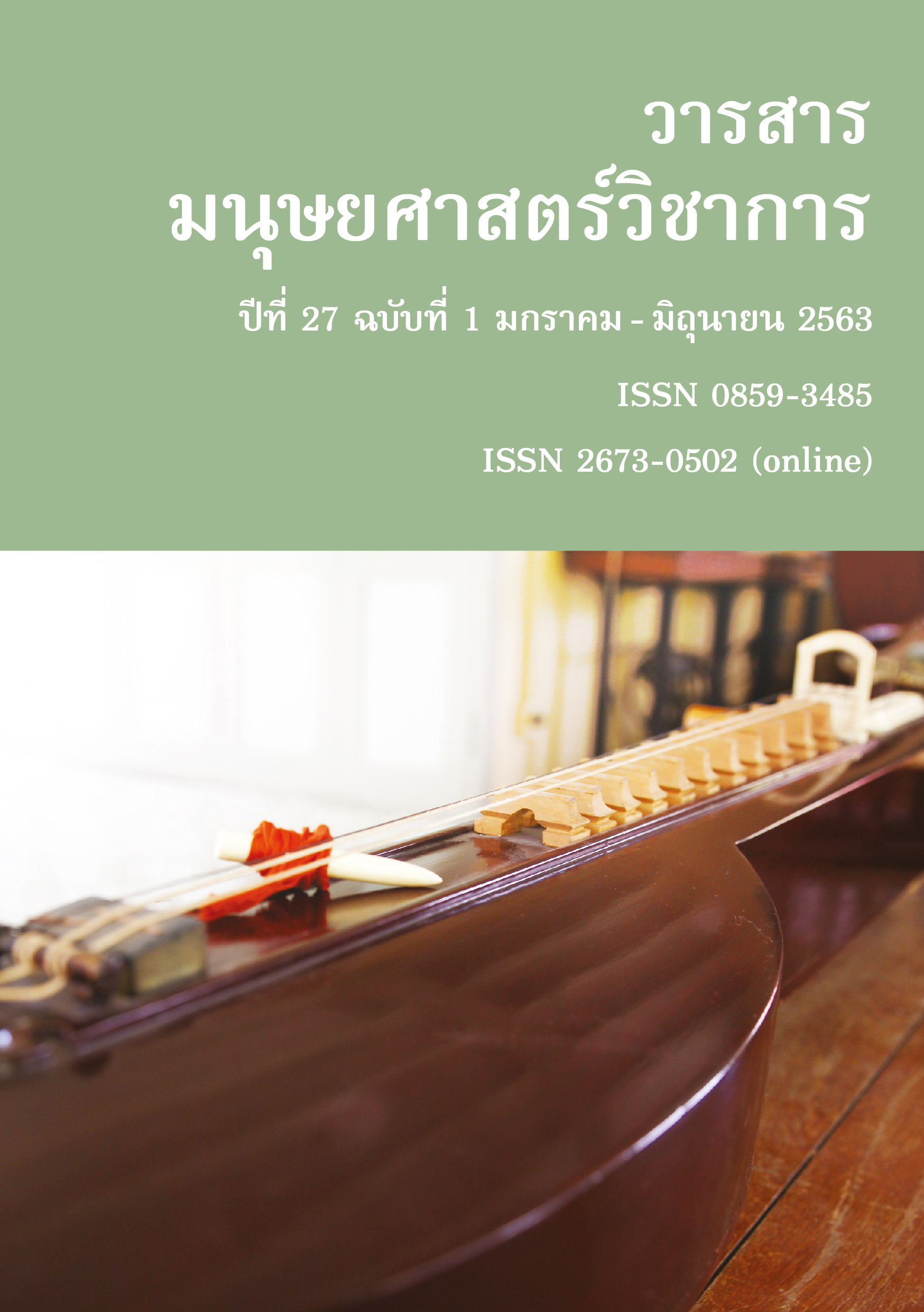Drag Queen Self-presentation of the Contestants in a Reality Show “Drag Race Thailand”
Main Article Content
Abstract
This research article aims to study context of communicative event and linguistic strategies in presenting the self of the contestants in the reality show “Drag Race Thailand”. This reality show is a search for Drag Queen who has a male body but they are capable of dressing up as beautiful women and have artistic acting skills. The data were collected from the Drag Race Thailand Season 1, 8 episode and season 2, 13 episodes, a total of 21 episodes from the LINE TV website.
It was found that the context of communicative event in the reality show “Drag Race Thailand” and important linguistic strategies of the contestants, who called themselves Drag Queen, are constructed by lexical selection and presupposition. These linguistic strategies are used to present that Drag Queen is a woman, Drag Queen is an art show, and Drag Queen has not been accepted by society and wants social acceptance. The self-presentation of these Drag Queen is not only the creation of their community but still want to create the self/identity and space for LGBT in Thai society as well.
Article Details
References
กรกมล ศรีวัฒน์. (2561, 15 สิงหาคม). Stand-up Comedy จักรวาลความฮาหลังไมค์หนึ่งตัว. สืบค้นเมื่อ 28 กรกฎาคม 2562 จาก https://today.line.me/th/pc/article/Stand+up+Comedy.
คณาธิป พาณิชตระกูล. (2556). ความสัมพันธ์ระหว่างภาษากับอุดมการณ์ ว่าด้วยชายรักชายในหนังสือพิมพ์รายวันภาษาไทย. (วิทยานิพนธ์ปริญญามหาบัณฑิ สาขาวิชาภาษาไทย). จุฬาลงกรณ์มหาวิทยาลัย, กรุงเทพฯ.
คมชััดลึึก. (2561, 24 มกราคม) มาทำความรู้จักกัับรายการ ‘กะเทย’ สุุดแซบ. สืืบค้นเมื่่อ 14 ธันวาคม 2562 จาก https://www.komchadluek.net/news/ent/310555.
ณิิชา พััฒนเลิิศพัันธ์ และธนศิิลป์ มีีเพีียร. (2561, 18 กุุมภาพันธ์). แดร็กควีนไม่ใช่นางโชว์ : คุยกับ ปันปัน นาคประเสริฐ พิธีกรร่วมรายการ Drag Race Thailand. สืืบค้นวันที่ 27 กรกฎาคม 2562 จาก https://thematter.co/rave/drag-race-thailandinterview/
ธีระ บุษบกแก้ว. (2553). กลวิธีทางภาษากับการนำเสนออัตลักษณ์ของตนเองโดยกลุ่ม “เกย์ออนไลน์” (วิทยานิพนธ์ปริญญามหาบัณฑิต สาขาวิชาภาษาไทย) จุฬาลงกรณ์มหาวิทยาลัย, กรุงเทพฯ.
พัทธมน สินธุวณิชเศรษฐ์. (2562, 7 พฤษภาคม). รูพอล “คุณแม่” แห่งแดรกควีน ผู้ยกวงการแดรกจากใต้ดินสู่บนดิน. สืบค้นเมื่อ 27 กรกฎาคม 2562 จาก https://thepeople.co/andre-charles-rupauls-drag-race/.
พิิมพ์วดีี รุ่งเรืืองยิ่่งและโสภีี อุ่นทะยา. (2560). กลวิิธีีทางภาษาสื่อวาทกรรมหญิิงรัักหญิิงในนิิตยสาร @tom actz. วารสารภาษา ศาสนา และวััฒนธรรม, 6(1), 59-82.
รัชนินท์ พงศ์อุดม. (2548). ความสัมพันธ์ระหว่างภาษากับค่านิยมเกี่ยวกับความงาม: การศึกษาวาทกรรมโฆษณาเครื่องสำอางในภาษาไทย (วิทยานิพนธ์ปริญญามหาบัณฑิต สาขาวิชาภาษาศาสตร์). จุฬาลงกรณ์มหาวิทยาลัย, กรุงเทพฯ.
วุฒินันท์ แก้วจันทร์เกตุ. (2553). อุดมการณ์ความเป็นชายในวาทกรรมโฆษณาสินค้าและบริการสำหรับผู้ชายในนิตยสารผู้ชาย (วิทยานิพนธ์ปริญญามหาบัณฑิต สาขาวิชาภาษาไทย). จุฬาลงกรณ์มหาวิทยาลัย, กรุงเทพฯ.
ศิริพร ภักดีผาสุข. (2553). โครงการวาทกรรม “ความเป็นผู้หญิง” ในนิตยสารสุขภาพ และความงามภาษาไทย. รายงานการวิจัยฉบับสมบูรณ์ภาควิชาภาษาไทย คณะอักษรศาสตร์ จุฬาลงกรณ์มหาวิทยาลัย.
ศิริพร ภักดีผาสุข. (2561). ความสัมพันธ์ระหว่างภาษากับอัตลักษณ์และแนวทางการนำมาศึกษาภาษาไทย. กรุงเทพฯ: โครงการเผยแพร่ผลงานวิชาการ คณะอักษรศาสตร์ จุฬาลงกรณ์มหาวิทยาลัย.
สุคนธรัตน์ สร้อยทองดี. (2552). การนำเสนออุดมการณ์ความเป็นแม่ในวาทกรรมโฆษณาในนิตยสารสำหรับครอบครัว (วิทยานิพนธ์ปริญญามหาบัณฑิต สาขาวิชาภาษาไทย) จุฬาลงกรณ์มหาวิทยาลัย, กรุงเทพฯ.
Barrett, R. (2017). From Drag Queens to Leathermen: Language, Gender, and Gay Male (Studies in Language, Gender and Sexuality). New York: Oxford University Press.
Brown, P and Levinson, S.C. (1987). Universals in Language Usage: Politeness Phenomena. In Goody, E.N. (Ed.) Questions and Politeness (pp. 56-289). Cambridge: Cambridge University Press.
Bucholtz, M., and Hall, K. (2004). Theorizing Identity in Language and Sexuality Research. Language in Society, 33(4), 469-515.
Butler, J. (1990). Gender trouble: Feminism and the subversion of identity. New York/London: Routhledge.
Halliday, M. A. K., & Matthiessen, C. (2014). Halliday’s Introduction to Functional Grammar (4th ed.). Oxon: Routledge.
Hymes, D. (1974). Foundations in Sociolinguistics: An Ethnographic Approach. London: Tavistock Publications.
Lakoff, R. (1973). The logic of politeness; or, minding your P’s and Q’s. In C. Corum, T. Cedric Smith-Stark, A. Weiser (eds.), the Ninth Regional Meeting of the Chicago Linguistics Society (pp. 292-305). Chicago: Department of Linguistics, University of Chicago.
Lakoff, R. (1975). Language and Woman’s Place. New York: Harper & Row.
Moncrieff, M. and Lienard, P. (2017). A Natural History of the Drag Queen Phenomenon. Evolutionary Psychology, 15(2), 1-14.
Ochs, E. and Taylor, C. (1992). Family Narrative as Political Activity. Discourse and Society, 3(3), 301-340.
Panpothong, N. (2011). Discourse of Plastic Beauty: A Critical Linguistic Analysis of Cosmetic Surgery Ads in Thai. The Journal, 6(2), 89-106.
Rupp, L & Taylor, V. (2003). Drag Queens at the 801 Cabaret. London: University of Chicago Press.
Simmons, N. (2014). Speaking Like a Queen in RuPaul’s Drag Race: Towards a Speech Code of American Drag Queens. Sexuality and Culture, 18(3), 630-48.
Tennen, D. (1990). You Just Don’t Understand: Women and Men in Conversation. New York: Wm. Morrow.
Zabbialini, G. (2019, March 27). “Girl, we are serving looks!”: the influence of drag queen’s language on the “beauty gurus” channels on YouTube. Retrieved July 28, 2019, from https://www.academia.edu/39236240/_Girl_we_are_serving_looks_the_influence_of_drag_queen_s_language_on_the_beauty_gurus_channels_on_YouTube/.


